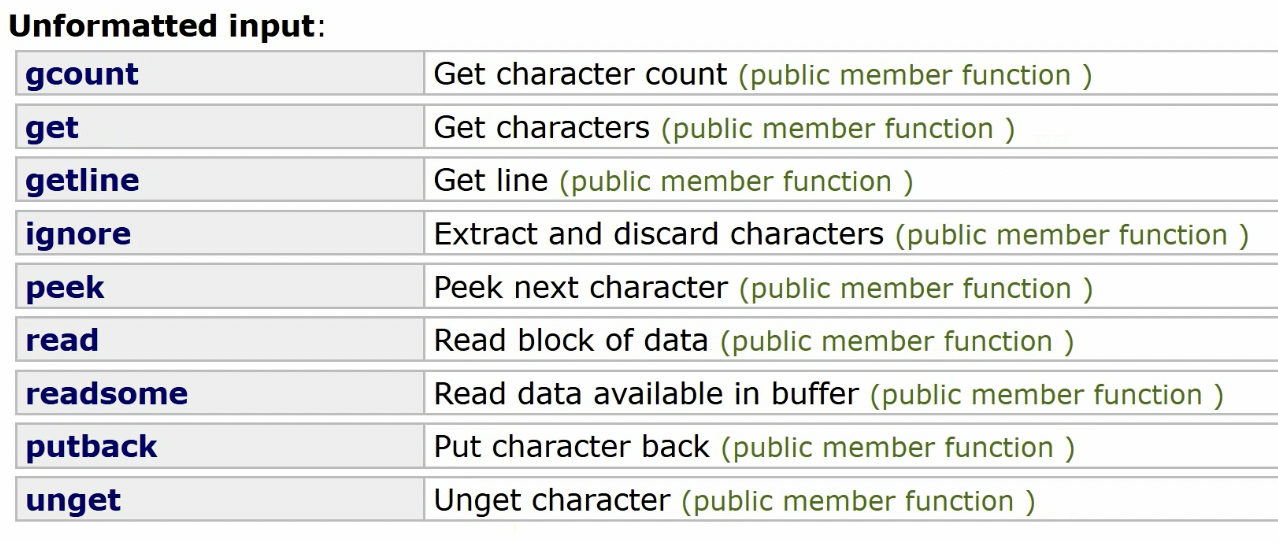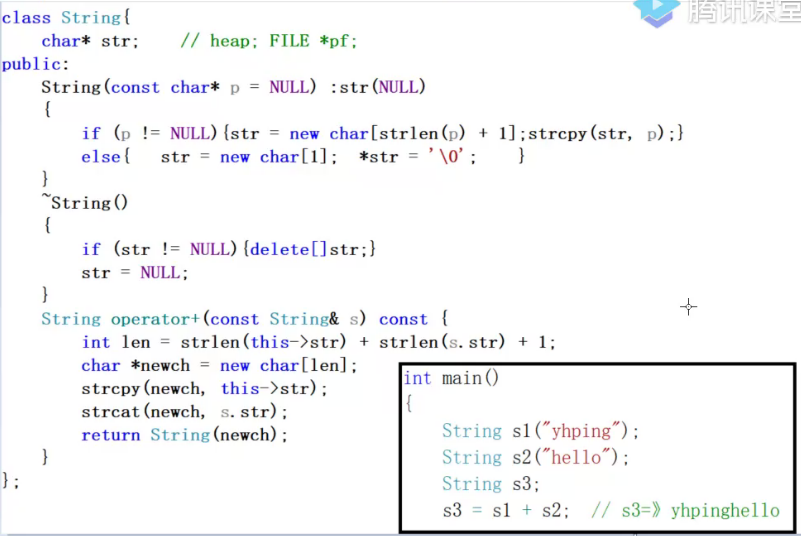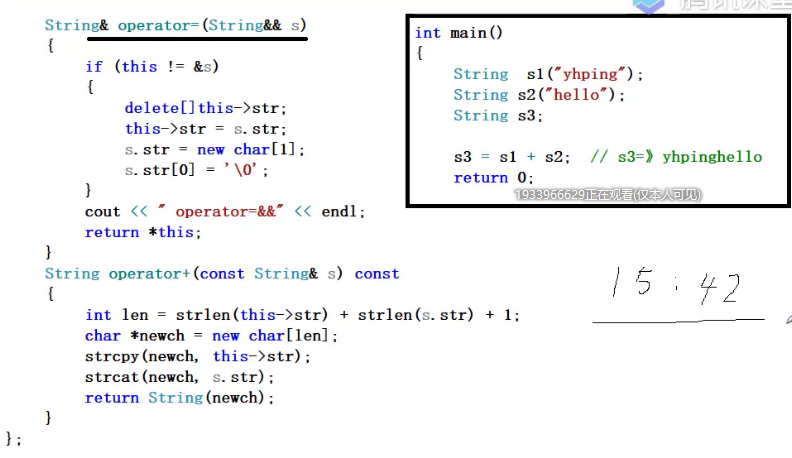内容
- 分析string的设计、实现
- 由at方法引出的
C++异常机制(有单独详细的文章)
- 由字符串对象的比较引出的
<compare>库、比较机制(三路比较)
cout输出流机制,以及引出的友元cin输入流机制- 引入右值引用拷贝、赋值
String的历史
在C++手册中的<string>header中,Class instantiations(类实例)有:string、u16string、u32string、wstring(宽字符)。
string 是 ANSI 规范的普通字符。
wstring(宽字符)是 Unicode 字符集,开发中推荐使用。
String方法
length():返回字符串有效字符长度,即不包括\0。size():也是返回有效字符长度。与length()等价。
- 但在 vector 中,二者有区别。
- Cpp字符串的长度函数是以上两个,调用形式是:
str.size() str.length()。而C语言的<cstring>中的调用形式是strlen(str)
仿写成员方法
基本思想1:体现面向对象中封装的特性:构造
基本思想2:RAII
RAII 全称 Resource Acquisition is Initialization. 这是C++的设计哲学。
意为:C++的对象在创建或构造时意味着初始化的开始,比如char * _str成员在string构造时自动地指向一块新申请的区域。那么,相对应的过程是析构就意味着要释放资源。这个过程就是推荐的C++对象的自然设计、自然行为。
而Java的设计理念是类启动时并没有进行初始化,还要进行init()。
常量字符串构造
std::string str("Hello")
1
2
3
4
5
6
7
8
9
10
11
12
13
14
15
16
17
18
| class MyString
{
public:
MyString(const char * str)
{
if(!str) return;
size_t len = strlen(str);
_str = new char[len + 1];
strcpy(_str, str);
}
const char * c_str(void) const
{
return _str;
}
private:
char * _str{ nullptr };
}
|
拷贝构造
1
2
3
4
5
6
7
8
9
10
11
| class MyString
{
public:
MyString(MyString const & str)
{
if(!str._str) return;
size_t len = strlen(str._str);
_str = new char[len + 1];
strcpy(_str, str._str);
}
}
|
赋值重载
把旧的内容清空,赋予新的内容。
1
2
3
4
5
6
7
8
9
10
11
12
13
14
15
16
17
18
19
20
21
22
23
24
25
26
27
28
29
30
31
32
33
34
35
| class MyString
{
public:
MyString& operator = (const char * str)
{
if(_str)
{
delete[] _str;
_str = nullptr;
}
if(str != nullptr)
{
size_t len = strlen(str);
_str = new char[len + 1];
strcpy(_str, str);
}
return *this;
}
MyString& operator = (MyString const & str)
{
if(&str == this) return *this;
if(_str)
{
delete[] _str;
_str = nullptr;
}
if(str._str != nullptr)
{
size_t len = strlen(str._str);
_str = new char[len + 1];
strcpy(_str, str._str);
}
return *this;
}
}
|
+=
两种情况:
- 类本身是空的,则直接new,复制
- 类有东西,则想办法搞合适的空间,追加
- 可能要扩容原空间
1
2
3
4
5
6
7
8
9
10
11
12
13
14
15
16
17
18
19
20
21
22
23
24
25
26
27
28
29
30
31
32
| class MyString
{
public:
MyString& operator += (const char * str)
{
if(!str) return *this;
size_t oldlen = strlen(_str);
size_t newlen = strlen(str);
if(newlen == 0) return *this;
char * newstr = new char[oldlen + newlen + 1];
strcpy(newstr, _str);
strcat(newstr, str);
if(_str != nullptr)
{
delete[] _str;
_str = nullptr;
}
_str = newstr;
return *this;
}
MyString& operator += (MyString const & str)
{
}
}
|
析构
1
2
3
4
5
6
7
8
| ~MyString()
{
if (_str)
{
delete[] _str;
_str = nullptr;
}
}
|
Boolean Operator
为了便于运算if(str)这类语句。C++11版本允许有bool运算符的重载。
bool运算符的重载的特点:
- 因为布尔运算符的返回值必须为Boolean,锁定了返回值类型,所以可以省略不写。
- 和小括号运算符不一样,小括号运算符可以返回任何值类型,但bool运算符必须返回boolean类型。
1
2
3
4
5
6
7
8
9
| class MyString
{
public:
operator bool() const
{
return _str;
}
}
|
at(抛异常,检查边界)
有两种:
-
at位置的字符不能修改
-
at位置的字符可以修改
-
可能会out of range。
-
返回的都是引用类型,引用不能为空,所以不能通过返回值是否为空来判断是否错误了,所以得用异常机制。
1
2
3
4
5
6
7
8
9
10
11
12
13
14
15
16
17
18
19
20
21
22
23
24
25
26
27
28
29
30
31
32
33
34
35
36
37
38
39
40
| #include<exception>
class OutOfRange : public std::exception
{
public:
OutOfRange() : std::exception{"MyString: out of range!"}
{
}
}
class MyString
{
public:
char & at(const size_t off)
{
size_t len = strlen(_str);
if(off > strlen - 1)
throw OutOfRange{};
return _str[off];
}
char const & at(const size_t off) const
{
size_t len = strlen(_str);
if(off > strlen - 1)
throw OutOfRange{};
return _str[off];
}
}
int main()
{
if(str)
{
try
{
std::cout << str.at(11) << std::endl;
}
catch (const std::exception &e)
{
std::cout << e.what() << std::endl;
}
}
}
|
[](不抛异常,不检查边界)
与at函数的不同在于,[]是不抛出异常的,因此不检查边界。如果越界,则行为未定义。
1
2
3
4
5
6
7
8
9
10
11
12
| class MyString
{
public:
char& operator[](const size_t off) noexcept
{
return _str[off];
}
char const & operator[](const size_t off) const noexcept
{
return _str[off];
}
}
|
<=>三路比较运算符
C++20标准中,有<compare>库。
strong_ordering
- less
- greater
- equal:相等
- equivalent:等价
weak_ordering
- less
- greater
- equivalent:等价,或者说模糊的相等
partial_ordering
- less
- greater
- equivalent
- unordered
strong_ordering测试如下
1
2
3
4
5
6
7
8
9
10
11
12
13
14
| #include<compare>
int main()
{
int a = 3;
int b = 4;
auto c = a <=> b;
if(c < 0)
std::cout << "less" << std::endl;
else if(c > 0)
std::cout << "greater" << std::endl;
else if(c == 0)
std::cout << "equal" << std::endl;
return 0;
}
|
partial_ordering测试如下,主要测试unordered的情况。用一个NaN浮点数比较时,就会出现。
NaN定义于limits库
1
2
3
4
5
6
7
8
9
10
11
12
13
14
15
16
| #include<limits>
int main()
{
double a = 4.0;
double b = std::numeric_limits<double>::quiet_NaN();
auto c = a <=> b;
if(c < 0)
std::cout << "less" << std::endl;
else if(c > 0)
std::cout << "greater" << std::endl;
else if(c == 0)
std::cout << "equivalent" << std::endl;
else
std::cout << "unordered" << std::endl;
return 0;
}
|
对于字符串来说,我们返回一个strong或weak都可以。strong要求肯定更严格一些,比如区分字母大小写等等,而weak要求则松一些,比如不管大小写,都算相等。
类中怎么使用<=>
- default的
<=>是按照类中的成员顺序依次比较。
- 如果不是按照默认顺序依次比较,则需要自定义函数逻辑
以下是默认的例子
1
2
3
4
5
6
7
8
9
10
11
12
13
14
15
16
17
18
19
20
| class Point
{
public:
Point(int x, int y) : _x{ x }, _y{ y }
{
}
std::strong_ordering operator <=> (Point const & pt) const = default;
private:
int _x;
int _y;
};
int main()
{
Point pt{1, 2}, pt2{1, 2};
if(pt == pt2)
{
std::cout << "equal" << std::endl;
}
}
|
string中的实现
以下回到MyString中的<=>比较运算符。我们定义其返回weak_ordering。即不管大小写混合与否,都是等价关系。总的来说,我们在大小写不敏感的情况下返回weak_ordering。
- 统一大小写,再比对,一样则返回等价,不一样则返回大、小
1
2
3
4
5
6
7
8
9
10
11
12
13
14
15
16
17
18
19
20
21
| #include<compare>
class MyString
{
public:
std::weak_ordering operator <=> (MyString const & other) const noexcept
{
int c = strcmp(_str, other.c_str());
if(c == 0)
return std::weak_ordering::equivalent;
else if(c > 0)
return std::weak_ordering::greater;
else
return std::weak_ordering::less;
}
}
|
类中只要定义了<=>这个运算符(参数是一个const 同类引用),那么,外部的比较运算符就转向运行该函数进行比较。
1
2
3
4
5
6
7
8
9
10
11
| int main()
{
MyString str{ "Hello" };
MyString str2{ "Hello" };
if(str == str2)
std::cout << "equal" << std::endl;
else if(str < str2)
std::cout << "less" << std::endl;
else
std::cout << "greater" << std::endl;
}
|
cout识别本类(全局重载)
cout 是 ostream 的实例。如果我们要做到让 cout 认识自定义类 MyString 的话,就需要重载 cout 的<<运算符。注意,与 MyString 的成员方法没关系,因为cout的形式是:std::cout << str。
1
2
3
4
5
| std::ostream& operator <<(std::ostream &os, MyString const & str)
{
os << str.c_str();
return os;
}
|
友元
假如类外部需要访问类内私有成员,则需要再类内任意位置授权该类外函数。即在函数声明形式的语句之前,加friend。
这是遵循封装性的程序设计下的一种妥协的通路。在特殊情况下,可以破坏封装性。
1
2
3
4
5
6
7
8
9
10
| class MyString
{
friend std::ostream& operator << (std::ostream& os, MyString const& str);
}
std::ostream& operator <<(std::ostream &os, MyString const & str)
{
os << str._str;
return os;
}
|
cin
cin 的位置在<istream>中。内部有输入缓冲区。以回车标志着输入完毕,空格标志着数据的间隔。
1
2
3
4
5
6
7
8
9
10
11
| #include <iostream>
int main()
{
std::string str;
std::string str2;
std::cin >> str;
std::cin >> str2;
}
|
cin的方法

cin.get()方法不带参数表示从缓冲区析出一个字符,并且不再返回缓冲区。
如果放在cin >> x的后面,前面>>已经把有效数据拿走,则此时恰好可以在间隔符(空格或回车)的位置上get,因此不会影响正常数据。
1
2
3
4
5
6
7
8
9
10
11
12
13
14
15
16
| #include <iostream>
int nums[100];
int main()
{
int i = 0;
while (std::cin >> nums[i++])
{
if (std::cin.get() == '\n')
break;
}
for (int j = 0; j < i; ++j)
std::cout << nums[j] << std::endl;
}
|
cin重载(全局)
首先调用cin的>>后用户要先输入一些东西,保存到了缓冲区。
需要用到cin.get(char* s, streamsize n)表示从缓冲区析出 n 个字符大小,写入 s 指向的区域中。
1
2
3
4
5
6
7
8
9
10
11
12
13
14
15
16
17
18
19
20
21
22
23
24
25
26
27
28
29
30
| std::istream& operator >>(std::istream& is, MyString const& str)
{
char * in_c_str = new char[1024];
memset(in_c_str, 0, 1024);
is.get(in_c_str, 1024);
if(!&str) return *this;
size_t inlen = strlen(in_c_str);
if(inlen == 0) return *this;
size_t oldlen = strlen(_str);
char * newstr = new char[oldlen + newlen + 1];
strcpy(newstr, _str);
strcat(newstr, in_c_str);
if(_str != nullptr)
{
delete[] _str;
_str = nullptr;
}
_str = newstr;
return is;
}
|
测试
1
2
3
4
5
6
7
8
9
10
11
12
13
14
15
16
17
18
| int main()
{
MyString str{"Hello"};
std::cout << str.c_str() << std::endl;
MyString str2{str};
std::cout << str2.c_str() << std::endl;
str = "Test =";
std::cout << str.c_str() << std::endl;
if(str)
{
std::cout << str.c_str() << std::endl;
}
str += "Test +=";
std::cout << str.c_str() << std::endl;
std::cout << str.at(5) << std::endl;
}
|
问题代码

问题:
- 在
return String(newch)后,不能delete该函数体中的缓冲区newch,造成内存泄漏。
- 系统崩溃。因为返回的将亡值
String(newch)在s3 = s1 + s2语句结束前浅拷贝,把有值的str给了s3的str。语句结束后自动析构,释放了堆区空间(String(newch)).str,虽然str置空了,但s3的str是脏值。
- 首先,由于堆区释放了,s3用不了了
- 其次更严重的是,main函数结束时由于s3的str为脏值,不为空,因此会再次
delete[]str,导致系统崩溃。
引入右值赋值函数

此时,等号赋值调用右值移动函数,将临时构造的s1+s2对象的str的拥有权转移给了s3。
将亡值
某一句表达式产生了一个不具有名字的实体。
生存期只存在某一句表达式中。
此实体即为将亡值。
右值引用
1
1
2
3
4
5
6
7
8
9
10
11
12
13
14
15
16
17
18
| String fun()
{
String s2 = ("yhping");
return s2;
}
int main()
{
String s1;
s1 = fun();
return 0;
}
|
2
1
2
3
4
5
6
7
8
9
10
11
12
13
14
15
16
| String & fun()
{
String s2 = ("yhping");
return s2;
}
int main()
{
String s1;
s1 = fun();
cout << s1 << endl;
return 0;
}
|
3
右值引用只能引用字面常量或无名量。左值引用不能引用无名量。
1
2
3
4
5
6
7
8
| int main()
{
String s1;
String & sx = s1;
String && sy = sx;
String && sz = String("hello");
}
|
1
2
3
4
5
| String && fun()
{
String s2("yhping");
return s2;
}
|
1
2
3
4
5
| int main()
{
int && a = 10;
int && b = a;
}
|
4
1
2
3
4
5
6
7
8
9
10
11
12
13
14
15
| class String
{
public:
String(String && s)
{
cout << "move copy construct :" << this << endl;
str = s.str;
s.str = NULL;
}
String& operator=(String && s)
{
}
};
|
写时拷贝的String
1
2
3
4
5
6
7
8
9
10
11
12
| int main()
{
String s1("xcgong");
String s2(s1);
String s3(s2);
String s4(s3);
}
|
写时拷贝的String是GCC里String的方案。


